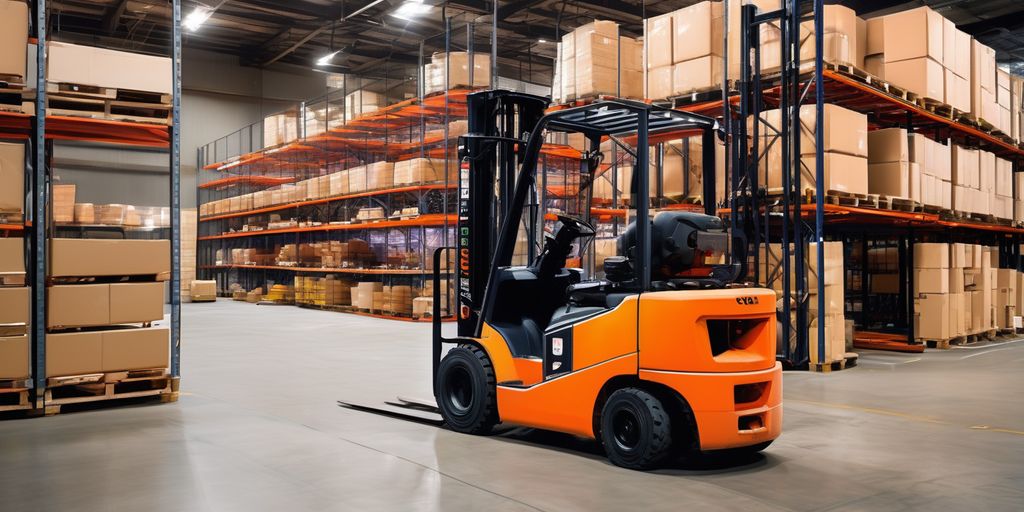Forklifts are essential in various industrial operations, and their maintenance is crucial for ensuring safety, efficiency, and longevity. A preventative maintenance checklist serves as a vital tool in managing the upkeep of forklifts, helping to identify potential issues before they lead to costly breakdowns or safety hazards. This article provides a comprehensive guide on creating and implementing an effective forklift maintenance schedule.
Key Takeaways
- Regular maintenance of forklifts prevents unexpected breakdowns and enhances operational efficiency.
- A systematic approach to forklift maintenance includes daily, weekly, monthly, and annual inspections.
- Utilizing a maintenance checklist ensures thorough assessment and servicing of all critical forklift components.
- Documentation of maintenance activities is essential for compliance and helps in tracking the forklift’s service history.
- Training and certification of operators play a crucial role in maintaining forklift safety and compliance.
Understanding Forklift Maintenance

Importance of Regular Checks
Regular maintenance checks are crucial for ensuring the operational efficiency and safety of forklifts. Ignoring warning signs can lead to unexpected breakdowns and costly repairs. Regular checks help identify potential issues before they escalate, contributing to a safer working environment.
Key Components to Monitor
Monitoring key components such as brakes, tires, and fluid levels is essential. Neglecting these can lead to severe operational issues. A structured checklist can aid in this process, ensuring no critical component is overlooked.
Benefits of Preventive Maintenance
Preventive maintenance not only extends the lifespan of the forklift but also enhances safety and efficiency. By proactively maintaining the forklift, organizations can avoid the high costs associated with major repairs and downtime.
Proactive maintenance is key to maximizing the lifespan and efficiency of forklifts.
Daily Maintenance Procedures

Checking Fluid Levels
Regularly checking fluid levels is crucial for the smooth operation of forklifts. This includes engine oil, coolant, transmission fluid, and hydraulic fluid. Ensure that all fluids are at the recommended levels and top them up if necessary. This simple step can prevent many common mechanical issues and extend the lifespan of the forklift.
Inspecting Tires and Wheels
Tires and wheels should be inspected daily for any signs of wear or damage. Proper tire pressure and condition are essential for safe operation. Look for cuts, punctures, or any deformities in the tires. Wheels should be checked for tightness and integrity to ensure they are securely attached and free from damage.
Assessing Forks and Chains
The forks and chains of a forklift are critical for its lifting capabilities. Regular inspections should include checking for any signs of wear, distortion, or damage. It is important to ensure that the forks are straight and the chains are adequately lubricated to maintain efficient operation. Any issues found during these checks should be addressed immediately to maintain safety and operational efficiency.
Weekly and Monthly Maintenance Tasks

Lubrication Requirements
Regular lubrication is crucial for the smooth operation of forklifts. Ensure all moving parts are adequately greased to prevent wear and tear. This includes mast components, chains, and bearings. Refer to the manufacturer's guidelines for specific lubrication intervals and recommended products.
Battery Maintenance and Charging
Proper maintenance of forklift batteries extends their life and ensures efficient operation. Key tasks include checking fluid levels, cleaning terminals, and ensuring the battery is charged according to the manufacturer's specifications. Remember, battery maintenance is essential for electric forklift longevity.
Cleaning and Clearing Debris
Keeping the forklift clean is not just about aesthetics; it's about functionality and safety. Monthly checks should include cleaning the air filter, removing debris from the radiator, and inspecting the lift and tilt cylinders. A clean forklift is less likely to suffer from mechanical issues.
Note: Always disconnect the battery before performing any maintenance tasks to ensure safety.
Annual Maintenance and Inspections

Structural Integrity Checks
Annual inspections are crucial to ensure the structural integrity of the forklift. This involves a thorough examination of the frame, mast, and overhead guard. Special attention should be paid to any signs of cracks or deformations which could compromise safety.
Engine and Transmission Assessment
A comprehensive assessment of the engine and transmission should be conducted annually to prevent costly repairs. This includes checking the engine's performance, transmission fluid levels, and the condition of the belts and hoses.
Safety Feature Evaluations
Evaluating the safety features of a forklift is essential to maintain compliance and protect operators. This includes testing the functionality of brakes, seat belts, and emergency stop buttons. Regular checks ensure that these critical components are always ready to perform in case of an emergency.
Note: Always ensure that maintenance tasks are performed by qualified personnel to maintain the highest standards of safety and efficiency.
Documentation and Compliance

Maintaining Service Records
Maintaining accurate service records is crucial for tracking the maintenance history and ensuring that all procedures are up-to-date. These records should include details such as the date of maintenance, services performed, parts replaced, and the technician's name. This documentation helps in demonstrating compliance with safety regulations and operational standards.
Understanding Compliance Requirements
Compliance with industry standards and safety regulations is mandatory to ensure the safe operation of forklifts. Regular audits and inspections are necessary to verify that the forklifts meet all required safety and operational guidelines. Documentation plays a key role in these processes, providing evidence of adherence to regulations.
Utilizing Maintenance Checklists
Checklists serve as vital documentation of maintenance activities. This record-keeping not only demonstrates compliance with safety regulations but also aids in tracking maintenance history. In the event of an inspection or audit, a well-maintained checklist can be a valuable resource to prove adherence to safety standards and regulations.
Troubleshooting Common Issues

Identifying Symptoms of Problems
To effectively troubleshoot forklift issues, it's crucial to first identify the symptoms accurately. Common signs include instability during lifting, unusual noises, and difficulty in steering or lifting. Recognizing these symptoms early can prevent more severe problems.
Effective Problem Solving Strategies
Once the symptoms are identified, applying structured problem-solving strategies is essential. For instance, if a forklift is not starting, check the battery's charge level and inspect for any loose connections. For steering issues, ensure the steering fluid levels are adequate and check for worn-out gears or pressure valves.
When to Seek Professional Help
There are instances when professional help is necessary, especially when the problems are beyond basic troubleshooting. If the issues persist after basic checks and repairs, it's advisable to consult with a technician. Technicians and engineers have the expertise to handle complex issues that might not be evident at first glance.
Enhancing Forklift Safety

Operator Training and Certification
Proper training and certification of forklift operators are crucial for ensuring safety in the workplace. It is essential that all operators are equipped with the knowledge and skills to handle forklifts safely. Training programs should cover operational procedures, safety protocols, and emergency responses.
Implementing Safety Protocols
Implementing robust safety protocols minimizes the risk of accidents and enhances safety. Regular drills and the dissemination of safety information keep safety practices fresh in the minds of employees. It is also vital to ensure that all safety equipment is accessible and in good working condition.
Regular Safety Audits
Conducting regular safety audits helps to identify and rectify potential safety hazards before they result in accidents. These audits should review compliance with safety standards and the effectiveness of existing safety measures. Regular feedback and updates on safety protocols are essential to maintain a safe working environment.
Conclusion
In conclusion, adhering to a comprehensive preventative maintenance checklist for forklifts is crucial for ensuring the safety, efficiency, and reliability of these vital industrial vehicles. Regular inspections and maintenance not only prevent sudden breakdowns and costly repairs but also extend the lifespan of the forklifts. By implementing the systematic approach outlined in this article, organizations can maintain operational efficiency, reduce downtime, and ensure a safer working environment for all. Remember, the key to effective forklift maintenance lies in consistency and adherence to the guidelines provided in the checklist.
Frequently Asked Questions
What is a forklift maintenance checklist?
A forklift maintenance checklist is a structured document or set of procedures used to inspect, assess, and maintain forklifts. It includes a series of maintenance and inspection tasks that need to be regularly performed to ensure the forklift's safe and efficient operation.
Why is preventive maintenance crucial for forklifts?
Preventive maintenance helps identify issues and wear-and-tear early, allowing for timely repairs or replacements. This approach minimizes sudden breakdowns, prevents disruptions, and reduces costly emergency repairs, enhancing the forklift's reliability and safety.
What are the benefits of using a forklift maintenance checklist?
Using a forklift maintenance checklist offers numerous benefits including improved safety, efficiency, and reliability of the forklift. It provides a systematic approach to servicing, which helps in maintaining operational continuity and reducing maintenance costs.
How often should forklift maintenance be performed?
Forklift maintenance should be performed regularly, following a schedule of daily, weekly, monthly, and annual inspection points. Specific forklift models may have unique requirements outlined in the manufacturer’s maintenance manual.
What are common issues with forklifts that require troubleshooting?
Common issues with forklifts include mechanical failures, hydraulic problems, electrical faults, and wear-and-tear of tires and chains. Effective troubleshooting involves identifying symptoms early and implementing problem-solving strategies or seeking professional help when necessary.
How can forklift safety be enhanced in industrial settings?
Enhancing forklift safety involves thorough operator training and certification, implementing strict safety protocols, and conducting regular safety audits. Adhering to a comprehensive maintenance checklist also plays a crucial role in ensuring the safety and efficiency of forklift operations.




Leave a comment
This site is protected by hCaptcha and the hCaptcha Privacy Policy and Terms of Service apply.